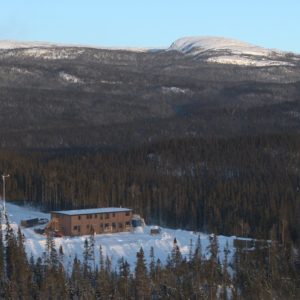About SHAPE Project
Structuring indigenous ecotourism
Uapishka Station is a partnership between the Innu Council of Pessamit and the Manicouagan-Uapishka World Biosphere Reserve (RMBMU). In February 2016, it acquired infrastructure at the foot of the Uapishka Mountains (Groulx) and near the Manicouagan reservoir, to establish a research and ecotourism station located within the Nitassinan of Pessamit and on a territory designated by UNESCO.

Building on the attractiveness of the exceptional features of the surrounding area, Uapishka Station provides accommodation and food services, as well as related logistical support services, for scientific and recreational activities. The Station operates all year round and its staff is over 50% Indigenous.
Its business model is based on the integration of three complementary mission elements that support both the financial objectives of the company and its social responsibility, with a view to protect and enhance the natural and cultural heritage of the Indigenous identity. The Uapishka Station acts as a structuring agent for:
- Stimulate the acquisition, sharing and diffusion of science and traditional knowledge;
- Develop human capital and promote the socio-professional integration of Indigenous people, especially youth;
- Promote dynamic and modern occupation of the Innu Nitassinan by enhancing its accessibility.
With its surpluses, Uapishka Station sets up and coordinates several social projects related to its mission, including hosting Indigenous trainees in the summer and organizing a territorial identity-building summer camp for young Innus. Recently, Uapishka Station confirmed the implementation of its Uetshu program, a socio-professional initiative for the next 3 years, for 12 young people from the Pessamit community, using the Station to enhance their appreciation of the labour market and to increase their capacity to integrate it.

Uapishka Station is a world-class destination. It implements an integrated ecotouristic approach that, while promoting accessibility to recreational activities for the discovery of the northern territory and the authenticity of the Aboriginal component, stimulates the acquisition, sharing and dissemination of scientific and traditional knowledge aimed at enhancing and preserving the natural and cultural heritage of its immediate environment. This concept, inspired by the standards of the World Tourism Organization in terms of sustainable tourism and ecotourism, is unique in Quebec and particularly well adapted to the distinctive features of the Plan Nord, simultaneously meeting several of its central objectives.
Through its operational logistics, Uapishka Station is also working in partnerships with different research institutions and consortia to act as a technology display for the testing of renewable energy generation in isolated environments. The Station uses and documents, in real operating conditions and throughout the year, technologies mainly related to biomass, wind and solar, with the aim of fostering an expertise to be exported in other nordic similar locations.




